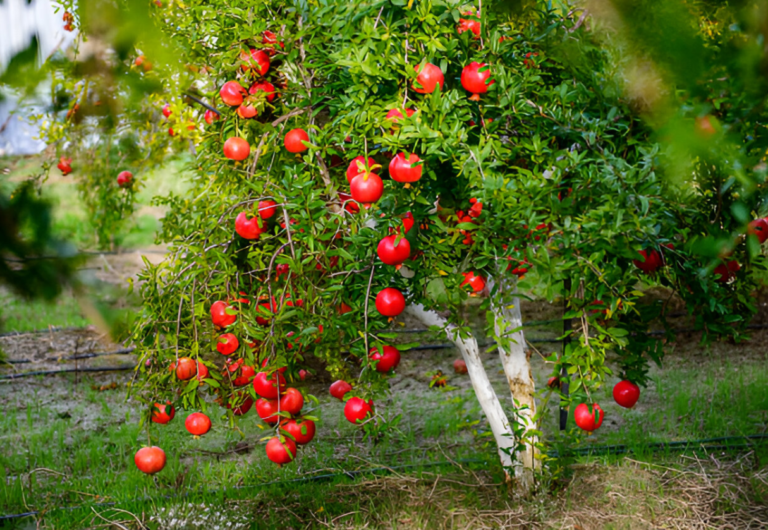Looking for a beautiful, fruit-bearing addition to your garden? The pomegranate tree could be your perfect match! 🌳 With its historical significance, vibrant blooms, and deliciously healthy fruit, this tree is both ornamental and practical. Let’s explore everything you need to know to successfully grow and care for a pomegranate tree.
Introduction to the Pomegranate Tree
The pomegranate tree (Punica granatum) has been cultivated for thousands of years, symbolizing prosperity and fertility across ancient civilizations. Originating in the Middle East and Mediterranean regions, it thrives in warm climates and produces fruit that is rich in antioxidants, vitamins, and minerals. With its striking red fruit and low maintenance needs, the pomegranate tree is a fantastic option for both novice and experienced gardeners.
For those looking to add vibrant plants to their garden, the pomegranate tree complements many others. If you’re planning to grow more plants from seed, you might find this guide to growing sunflowers useful for adding a variety of blooms.
Best Varieties of Pomegranate Tree
There are several varieties of the pomegranate tree, each offering unique characteristics. Here are some of the most popular:
- Wonderful Pomegranate: This variety is the most widely grown, producing large, red fruit with a tangy-sweet flavor.
- Angel Red Pomegranate: Known for its sweeter, softer seeds, which are easier to eat fresh.
- Sweet Pomegranate: As its name suggests, this variety produces very sweet fruit, making it a great choice for eating raw.
Different climates and soil types might influence your variety selection. For more ideas on adding beautiful flowering plants to your garden, take a look at this comprehensive guide on crape myrtle flowers.
How to Plant a Pomegranate Tree: Step-by-Step Guide
Planting a pomegranate tree correctly is the first step toward a fruitful harvest. These trees thrive in USDA hardiness zones 7-12 and love full sun. Here’s how to plant them:
Climate and Location
To grow healthy pomegranates, ensure the tree receives at least six hours of sunlight daily. Choose a sunny spot with well-drained soil, as waterlogged roots can lead to diseases.
Soil Requirements
Pomegranates prefer loamy soil with a neutral pH level, but they can tolerate a variety of soil conditions. If needed, you can amend the soil with organic compost to enhance drainage.
Planting Steps
- Dig a hole twice as wide and as deep as the tree’s root ball.
- Place the tree in the hole, ensuring the root flare is at soil level.
- Backfill the hole with soil, pressing down gently to remove air pockets.
- Water thoroughly and apply a layer of mulch around the base to retain moisture.
Pomegranate Tree Care: Watering, Pruning, and Fertilizing Tips
Pomegranate trees are relatively low-maintenance, but a few key practices will keep them thriving.
Watering
While pomegranate trees are drought-tolerant, regular watering during the fruiting season helps ensure larger, juicier fruit. Water deeply once every two weeks, or more often in particularly dry conditions.
Mulching
Adding a thick layer of organic mulch helps retain soil moisture, reduce weeds, and regulate soil temperature. Spread the mulch around the tree, but avoid piling it against the trunk to prevent rot.
For more tips on using natural fertilizers in your garden, check out this guide to using fish scraps as natural fertilizer.
Pruning
Pruning is essential for maintaining the shape of the tree and encouraging healthy growth. Prune your pomegranate tree in late winter or early spring before new growth begins. Remove dead or damaged branches, and thin the canopy to allow sunlight to reach all parts of the tree.
Common Pomegranate Tree Diseases and Pests
While pomegranate trees are hardy, they can sometimes suffer from pests and diseases. Here’s how to keep your tree healthy:
Pests
- Aphids, mealybugs, and whiteflies are common pests that can weaken your tree. Organic solutions, such as insecticidal soap or introducing beneficial insects like ladybugs, can help manage these pests.
Diseases
- Fungal infections like fruit rot and leaf spot can be caused by excessive moisture or poor air circulation. Regular pruning and avoiding overwatering can help reduce the risk of fungal diseases.
For more detailed information on how to manage common garden pests like aphids, you can visit this comprehensive guide.
Harvesting and Storing Pomegranates
Once your tree starts bearing fruit, usually after three to four years, it’s time to enjoy the harvest. Pomegranates are typically ready to pick in late summer or fall.
How to Harvest
- Wait until the fruit is deep red and feels heavy for its size.
- Use pruning shears to cut the fruit from the branch, leaving a small stem attached to prevent rot.
Storing
- Fresh pomegranates can be stored in a cool, dry place for several weeks or in the refrigerator for up to two months.
- For longer storage, you can freeze the seeds or juice.
Health Benefits of Pomegranate Juice
Pomegranate juice is a powerhouse of nutrients. It’s loaded with antioxidants such as punicalagins, which help reduce inflammation, improve heart health, and boost your immune system. 💪
Regular consumption of pomegranate juice may:
- Improve heart health by lowering blood pressure and bad cholesterol.
- Fight inflammation and reduce the risk of chronic diseases like arthritis.
- Aid digestion with its natural fiber content. 🍹
Want to learn more about the health benefits of pomegranate juice? Check out this detailed nutritional breakdown.
Conclusion
Growing a pomegranate tree is a rewarding experience, offering both beauty and delicious, nutritious fruit. By following the right planting and care techniques, you’ll enjoy bountiful harvests for years to come. Whether you’re new to gardening or an experienced green thumb, the pomegranate tree is an excellent addition to any garden.
If you’re ready to expand your garden with more unique plants, you might also enjoy this guide on growing saffron in containers. Happy gardening! 🌳🍎
